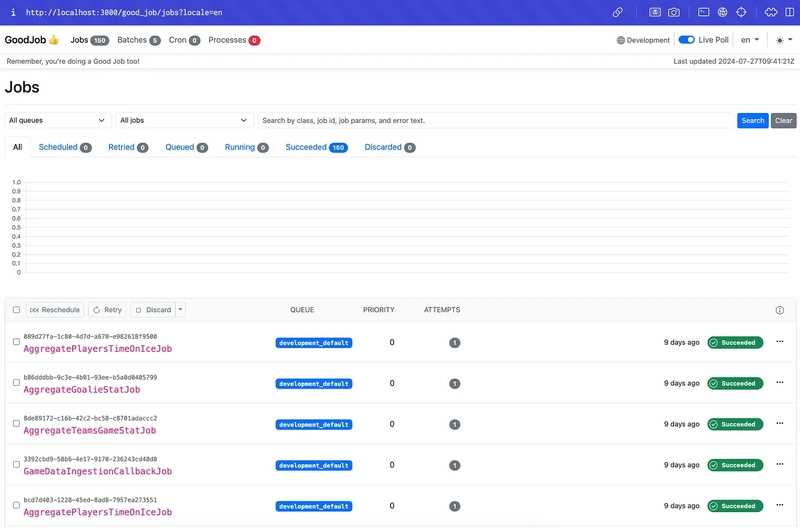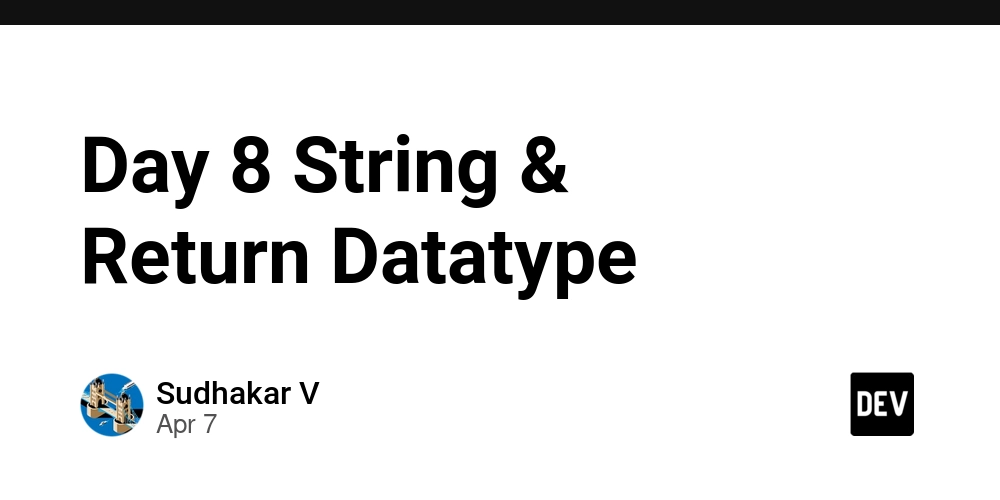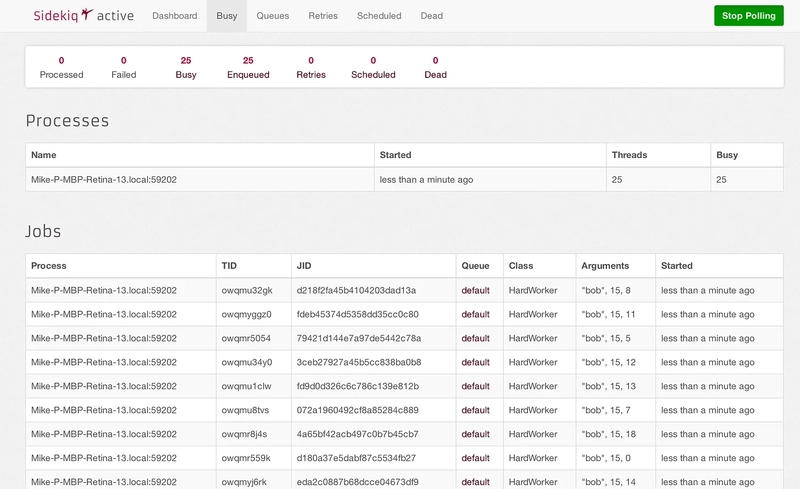Sidekiq vs GoodJob: A Comprehensive Comparison
In the Rails ecosystem, job processing libraries are essential for managing background tasks efficiently. We will compare their features, usability, and suitability for different project needs. Documentation Overview GoodJob offers a single README.md file that is densely packed with information, which may overwhelm some users. In contrast, Sidekiq utilizes GitHub's Wiki feature, providing easier navigation and topic-specific searches. While GoodJob's documentation is comprehensive, it can be challenging to find specific information compared to the better readability and ease of use found in Sidekiq. Batches and Callbacks When it comes to batch processing, Sidekiq and GoodJob take distinctly different approaches: Sidekiq excludes batch features from its free version. Users must upgrade to Pro or Enterprise plans to access this functionality, which may pose a barrier for smaller projects or teams with limited budgets. GoodJob includes batch processing by default, allowing users to implement this feature without additional costs. This community-driven gem eliminates the need for extra plugins or upgrades. Features Comparison Definition: In Sidekiq Pro, batches refer to collections of jobs monitored as a group. You can create a set of jobs to execute in parallel and then execute a callback when all jobs are finished. GoodJob tracks a set of jobs and enqueues an optional callback job when all the jobs have finished (succeeded or discarded). Jobs can be added to an existing batch? Yes for both. Access batch information: Yes for both. Callback with statuses: Sidekiq uses statuses like complete, success, and death. GoodJob uses finish, success, and discard. Linger and Expiration: Sidekiq's batch data lingers in Redis for 24 hours and expires after 30 days. In contrast, GoodJob ensures that batch information persists in the database before processing. Scheduled Jobs: Sidekiq does not have built-in support for scheduled jobs without upgrading. GoodJob supports both CLI and async execution modes and includes a dedicated Cron tab for managing scheduled tasks. Web UI Management Both libraries offer web interfaces with distinct features: Common Features Support authentication and authorization. Offer a polling feature for job status updates. Provide comprehensive dashboards for monitoring job queues. Allow micromanagement capabilities such as retrying and discarding jobs. Unique Features Authentication: Sidekiq supports many identity providers (e.g., Google, GitHub), while GoodJob offers basic authentication with role-based access. Filtering: Sidekiq does not support filtering from the UI, whereas GoodJob provides various filtering options by queue, job type, and parameters. Process or Thread Information: Available in Sidekiq but not in GoodJob. Reschedule Job?: Yes in GoodJob; no in Sidekiq. Error Handling and Dead Job Management Both libraries effectively handle errors during job execution: Both catch exceptions during job execution and log errors with details. They support automatic retries on failure with configurable limits. Both integrate with Rails logger for customizable logging. Dead Job Handling Sidekiq moves failed jobs to a separate "Dead Job Queue" after exhausting all retry attempts and automatically prunes dead jobs after six months. GoodJob keeps dead jobs in the same database as other job records, making them easier to manage using standard SQL tools. It allows custom error handling through ActiveJob callbacks. Job Prioritization Sidekiq Allows multiple queues for effective priority management. Jobs are processed based on queue priority; within a single queue, they follow FIFO (First In, First Out) order. GoodJob Supports multiple queues with a priority attribute for granular control. Considers both queue and job priority when selecting which job to run next. In both libraries, a higher-priority queue will process its jobs before lower-priority queues. However, this strategy can lead to potential issues; if a job within a high-priority queue is suspended or fails, it can cause all lower-priority queues to wait indefinitely. Within a single queue, jobs with higher priority will execute before those with lower priority. This feature provides more granular control over job execution timing, allowing less urgent tasks to wait until resources are available. Data Retention and Cleanup GoodJob uses a database for long-term storage with configurable retention periods. In contrast, Sidekiq primarily uses Redis, which automatically expires data after completion. Key Differences Storage Mechanism: Sidekiq relies on ephemeral Redis storage while GoodJob uses a database. Historical Data Management: GoodJob is better suited for maintaining longer-term job history compared to Sidekiq's focus on current tasks. Configuration Flex

In the Rails ecosystem, job processing libraries are essential for managing background tasks efficiently. We will compare their features, usability, and suitability for different project needs.
Documentation Overview
GoodJob offers a single README.md file that is densely packed with information, which may overwhelm some users. In contrast, Sidekiq utilizes GitHub's Wiki feature, providing easier navigation and topic-specific searches. While GoodJob's documentation is comprehensive, it can be challenging to find specific information compared to the better readability and ease of use found in Sidekiq.
Batches and Callbacks
When it comes to batch processing, Sidekiq and GoodJob take distinctly different approaches:
- Sidekiq excludes batch features from its free version. Users must upgrade to Pro or Enterprise plans to access this functionality, which may pose a barrier for smaller projects or teams with limited budgets.
- GoodJob includes batch processing by default, allowing users to implement this feature without additional costs. This community-driven gem eliminates the need for extra plugins or upgrades.
Features Comparison
- Definition: In Sidekiq Pro, batches refer to collections of jobs monitored as a group. You can create a set of jobs to execute in parallel and then execute a callback when all jobs are finished. GoodJob tracks a set of jobs and enqueues an optional callback job when all the jobs have finished (succeeded or discarded).
- Jobs can be added to an existing batch? Yes for both.
- Access batch information: Yes for both.
- Callback with statuses: Sidekiq uses statuses like complete, success, and death. GoodJob uses finish, success, and discard.
- Linger and Expiration: Sidekiq's batch data lingers in Redis for 24 hours and expires after 30 days. In contrast, GoodJob ensures that batch information persists in the database before processing.
- Scheduled Jobs: Sidekiq does not have built-in support for scheduled jobs without upgrading. GoodJob supports both CLI and async execution modes and includes a dedicated Cron tab for managing scheduled tasks.
Web UI Management
Both libraries offer web interfaces with distinct features:
Common Features
- Support authentication and authorization.
- Offer a polling feature for job status updates.
- Provide comprehensive dashboards for monitoring job queues.
- Allow micromanagement capabilities such as retrying and discarding jobs.
Unique Features
- Authentication: Sidekiq supports many identity providers (e.g., Google, GitHub), while GoodJob offers basic authentication with role-based access.
- Filtering: Sidekiq does not support filtering from the UI, whereas GoodJob provides various filtering options by queue, job type, and parameters.
- Process or Thread Information: Available in Sidekiq but not in GoodJob.
- Reschedule Job?: Yes in GoodJob; no in Sidekiq.
Error Handling and Dead Job Management
Both libraries effectively handle errors during job execution:
- Both catch exceptions during job execution and log errors with details.
- They support automatic retries on failure with configurable limits.
- Both integrate with Rails logger for customizable logging.
Dead Job Handling
- Sidekiq moves failed jobs to a separate "Dead Job Queue" after exhausting all retry attempts and automatically prunes dead jobs after six months.
- GoodJob keeps dead jobs in the same database as other job records, making them easier to manage using standard SQL tools. It allows custom error handling through ActiveJob callbacks.
Job Prioritization
Sidekiq
- Allows multiple queues for effective priority management.
- Jobs are processed based on queue priority; within a single queue, they follow FIFO (First In, First Out) order.
GoodJob
- Supports multiple queues with a priority attribute for granular control.
- Considers both queue and job priority when selecting which job to run next.
- In both libraries, a higher-priority queue will process its jobs before lower-priority queues. However, this strategy can lead to potential issues; if a job within a high-priority queue is suspended or fails, it can cause all lower-priority queues to wait indefinitely.
- Within a single queue, jobs with higher priority will execute before those with lower priority. This feature provides more granular control over job execution timing, allowing less urgent tasks to wait until resources are available.
Data Retention and Cleanup
GoodJob uses a database for long-term storage with configurable retention periods. In contrast, Sidekiq primarily uses Redis, which automatically expires data after completion.
Key Differences
- Storage Mechanism: Sidekiq relies on ephemeral Redis storage while GoodJob uses a database.
- Historical Data Management: GoodJob is better suited for maintaining longer-term job history compared to Sidekiq's focus on current tasks.
- Configuration Flexibility: GoodJob offers more detailed control over job record retention compared to Sidekiq's simpler setup.
Conclusion
Both Sidekiq and GoodJob offer robust job processing capabilities but cater to different needs within the Ruby on Rails ecosystem:
- Sidekiq is ideal for teams seeking straightforward setups willing to invest in premium features. Its reliance on Redis allows quick access but limits long-term data retention.
- GoodJob, embracing an open-source philosophy, provides comprehensive features without additional costs. Its use of PostgreSQL allows better long-term data management, making it suitable for applications requiring detailed historical insights.
Ultimately, your choice between Sidekiq and GoodJob should align with your project requirements, budget considerations, and desired level of control over job processing and data management. Evaluate your unique needs to determine which library fits best with your workflow and objectives.


















_Igor_Mojzes_Alamy.jpg?#)



















































![[FREE EBOOKS] AI Explained, Excel Insights & Four More Best Selling Titles](https://www.javacodegeeks.com/wp-content/uploads/2012/12/jcg-logo.jpg)






